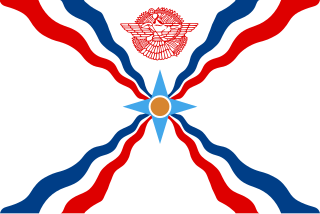 W
WThe Aramean flag or Syriac-Aramean flag is the ethnic flag designated for the Arameans, intended to represent their nation and homeland as well as the Aramean diaspora. The flag was first used in 1975 by the Aramean Association of Sweden and later adopted and redesigned by Bahro Suryoyo the Aramean journal which is part of the Syriac federation in Sweden. The World Council of Arameans, an international non-government umbrella organization, which is recognized by the United Nations officially choose the flag to represent the Syriac-Aramean nation worldwide on 16 July 1983 in New Jersey. The design was based on the Winged Sun symbol, replacing the sun by a torch symbolising the Holy Spirit in Christianity.
 W
WThe Assyrian flag is the flag chosen by the Assyrian people to represent the Assyrian nation in the homeland and in the diaspora.
 W
WBaucent was the name of the war flag used by the Knights Templar in the 12th and 13th centuries. 13th-century sources show it as a white gonfanon with a black chief . Jacques de Vitry, writing in the 1220s, mentions the gonfanon baucent and explains that the black and white colours symbolise the Templar's ferocity towards their enemies and their kindness towards their friends. It appears that later in the 13th century, the red cross of the Templar could be added to the banner. In a damaged fresco of the late 13th century in the Templar church of San Bevignate, Perugia, a Templar banner is depicted with the upper half in white and the lower half in black, with the red cross patty attached to the white field. The same fresco also shows a shield and horse-covers in the same design.
 W
WThe Black Banner or Black Standard is one of the flags flown by Muhammad in Muslim tradition. It was historically used by Abu Muslim in his uprising leading to the Abbasid Revolution in 747 and is also associated with the Abbasid Caliphate. It is also a symbol and is associated with the Islamic eschatology. The Black Banner, which is different from the flag used by IS, has been used by some jihadist and other militant groups since the 1990s, including some Chechen groups. Scholars have interpreted IS's use of a similar black flag as representing their claim to re-establishing a Caliphate. Similar black flags have been used throughout Islamic history, including in Afghanistan during the early 20th century.
 W
WThe Buddhist flag is a flag designed in the late 19th century as a universal symbol of Buddhism. It is used by Buddhists throughout the world.
 W
WThe Christian Flag is an ecumenical flag designed in the early 20th century to represent much of Christianity and Christendom. Since its adoption by the United States Federal Council of Churches in 1942, it has been used by congregations of many Christian traditions, including Anglican, Baptist, Congregationalist, Lutheran, Mennonite, Methodist, Moravian, Presbyterian, and Reformed, among others.
 W
WThe Coptic flag was created in 2005 by Coptic activists in different countries to represent Coptic communities both in Egypt and in the Coptic diaspora. It is not recognized by the Coptic Orthodox Church of Alexandria, and it is not recognized by any official Coptic organization. The only Coptic organization that has recognized the flag is the New Zealand Coptic Association, which is the same association that created the flag. and the Free Copts.
 W
WThe flag of Israel was adopted on 28 October 1948, five months after the establishment of the State of Israel. It depicts a blue hexagram on a white background, between two horizontal blue stripes. The Israeli flag legislation states that the official measurements are 160 × 220 cm. Therefore, the official proportions are 8:11. Variants can be found at a wide range of proportions, with 2:3 being common.
 W
WThe first use of the Compass Rose emblem of the Anglican Communion was occasioned by the convening in 1954 of "The First World Congress of the Anglican Communion" at The Cathedral Church of St. Mark, Minneapolis, Minnesota, all as is memorialized in stone at the crossing of the cathedral. It was designed in that year for the Congress by The Canon Edward N. West of the Cathedral Church of Saint John the Divine in New York. The Compass Rose was modernized in 1988 and the new design was laid into the floor of Canterbury Cathedral during the Twelfth Lambeth Conference of Anglican bishops.
 W
WThe Flag of the Church in Wales is the flag used to represent the Church in Wales. It consists of a blue cross on a white background with a gold celtic cross in the centre. It was adopted in 1954 by the Governing Body.
 W
WThe Ecumenical Patriarchate and Mount Athos, and also the Greek Orthodox Churches in the diaspora under the Patriarchate use a black double-headed eagle in a yellow field as their flag or emblem.
 W
WThe flag of Jainism has five colours: red, yellow, white, green and black. These five colours represent the Pañca-Parameṣṭhi. It also represents the five main vows, which are small as well as great.
 W
WThe jihadist flag is a flag commonly used by various Islamist and Islamic fundamentalist movements for jihad. It usually consists of a black background with a white text of the shahada emblazoned across it in calligraphy style writing. Its usage was widely adopted by jihadists in the early 2000s, and in the 2010s by the Islamic State. Aside from Islamism, the flag has also been used by various Islamic terrorist organizations.
 W
WKhorugv, is a religious banner used liturgically in the Eastern Orthodox and Eastern Catholic Churches.
 W
WThe Nishan Sahib is a Sikh triangular flag made of cotton or silk cloth, with a tassel at its end. The word, Nishan Sahib means exalted ensign, and the flag is hoisted on a tall flagpole, outside most Gurdwaras. The flagpole itself, covered with fabric, ends with a Arrow on top. The emblem on the flag is known as Khanda, which depicts a double-edged sword called a khanda (☬) in the centre, a chakkar which is circular, and flanked by two single-edged swords, or kirpans. Almost all Sikh warriors used to wear it in the eighteenth century, and Nihangs of today still do. The Khanda Sahib is not to be confused with the Nihang's Aad Chand which was the first symbol of the Khalsa. The Khanda was not introduced by Guru Hargobind Sahib Ji but it was a plain yellow banner.
 W
WThe flag of Vatican City was adopted on 7 June 1929, the year Pope Pius XI signed the Lateran Treaty with Italy, creating a new independent state governed by the Holy See. The Vatican City flag is modeled on the 1808 yellow and white flag of the earlier Papal States, to which a papal tiara and keys were later added. The Vatican also refers to it, interchangeably, as the flag of the Holy See.
 W
WThe Vinland flag is a Nordic cross flag designed by American Gothic metal band Type O Negative. The flag was used to symbolize a variety of front man Peter Steele's interests and political ideals, including his own Scandinavian heritage. Viking explorers visiting North America around the year 1000 called one of the areas they came to "Vinland". The flag appears on various compact disc covers produced by the group, sometimes with the slogan "made in the People's Technocratic Republic of Vinland", and adorns various pieces of Type O Negative merchandise. The flag strongly resembles the unofficial flag of the Forest Finns adopted in 1978.